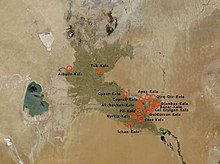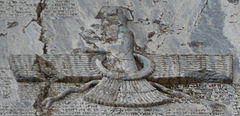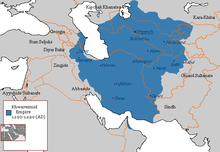Khwarazm
[5] In Avestan the name is Xvairizem; in Old Persian 𐎢𐎺𐎠𐎼𐏀𐎷𐎡𐏁 u-v-a-r-z-mi-i-š or 𐎢𐎺𐎠𐎼𐏀𐎷𐎡𐎹 u-v-a-r-z-mi-i-y (/hUvārazmī-/); in Modern Persian: خوارزم Xārazm; in Arabic: خَـوَارِزْم Khawārizm; in Old Chinese *qʰaljɯʔmriɡ (呼似密); in Modern Chinese Huālázǐmó (花剌子模 / Xiao'erjing: خُوَلاذِمُوْ); in Tajik: Хоразм, Xorazm, خوارَزم; in Kazakh: Хорезм (Xorezm), حورەزم; in Uzbek: Xorazm, Хоразм, خورەزم; in Turkmen: Horezm, Хорезм, خوْرِزم; in Azerbaijani: Xarəzm, Харәзм; in Turkish: Harezm; in Greek language Χορασμία (Chorasmía) and Χορασίμα (Chorasíma) by Herodotus.The Arab geographer Yaqut al-Hamawi in his Muʿǧam al-Buldan wrote that the name was a Persian compound of khwar (خوار), and razm (رزم), referring to the abundance of cooked fish as a main diet of the peoples of this area.Some of the early scholars believed Khwarazm to be what ancient Avestic texts refer to as Airyanem Vaejah (Airyanəm Vaēǰah; later Middle Persian Ērān-wēz).[8] These sources claim that Old Urgench, which was the capital of ancient Khwarazm for many years, was actually Ourva, the eighth land of Ahura Mazda mentioned in the Pahlavi text of Vendidad.[9] However, Michael Witzel, a researcher in early Indo-European history, believes that Airyanem Vaejah was in what is now Afghanistan, the northern areas of which were a part of ancient Khwarazm and Greater Khorasan.[16] Chorasmian troops participated in the Second Persian invasion of Greece by Xerxes in the 480 BC, under the command of Achaemenid general and later satrap Artabazos I of Phrygia.When the king of Khwarezm offered friendship to Alexander in 328 BC, Alexander's Greek and Roman biographers imagined the nomad king of a desert waste, but 20th-century Russian archeologists revealed the region as a stable and centralized kingdom, a land of agriculture to the east of the Aral Sea, surrounded by the nomads of Central Asia, protected by its army of mailed horsemen, in the most powerful kingdom northwest of the Amu Darya (the Oxus River of antiquity).The king's emissary offered to lead Alexander's armies against his own enemies, west over the Caspian towards the Black Sea (e.g. Kingdom of Iberia and Colchis).[citation needed] Per Al-Biruni, the Afrighids of Kath (آفریغیان-آل آفریغ) were a native Khwarezmian Iranian dynasty[12][43] which ruled as the Shahs of Khwarezm from 305 to 995 AD.In the course of the 10th century—when some geographers such as Istakhri in his Al-Masalik wa-l-mamalik mention Khwarezm as part of Khorasan and Transoxiania—the local Ma'munids, based in Gurganj on the left bank of the Amu Darya, grew in economic and political importance due to trade caravans.From then on, Turko-Mongolian invasions and long rule by Turko-Mongol dynasties supplanted the Iranian character of the region[43] although the title of Khwarezm-Shah was maintained well up to the 13th century.In 1194, the last Sultan of the Great Seljuq Empire, Toghrul III, was defeated and killed by the Khwarezm ruler Ala ad-Din Tekish, who conquered parts of Khorasan and western Iran.[citation needed] In 1360 there arose in Ḵwarazm an independent minor dynasty of Qunghrat Turks, the Ṣūfīs, but Solaymān Ṣūfī was crushed by Timur in 1388.[citation needed] Other examples illustrate the eminent status of Khwarezmid and Transoxianian cities in Persian literature in the past 1500 years: عالم جانها بر او هست مقرر چنانک The world of hearts is under his power in the same manner that دولت خوارزمشاه داد جهان را قرار The Khwarazmshahs have brought peace to the world.یکی پر طمع پیش خوارزمشاه A greedy one went to Khwarezm-shah شنیدم که شد بامدادی پگاه early one morning, so I have heard.The verse below refers to an early previous calamity that fell upon the region: آخر ای خاک خراسان داد یزدانت نجات Oh land of Khorasan!God has saved you, از بلای غیرت خاک ره گرگانج و کات from the disaster that befell the land of Gurganj and Kath.










Khorezm People's Soviet RepublicKhanate of KhivaKhorazm RegionKhorasanKhwarezmian (disambiguation)Central AsiaTurkmenistanUzbekistanOld PersianPersianAmu Daryariver deltaAral SeaKyzylkum DesertKarakum DesertUstyurt PlateauIranianKhwarezmianAfrighid dynastyAnushtegin dynastyKonye-UrgenchAvestanModernArabicOld ChineseModern ChineseXiao'erjingKazakhTurkmenAzerbaijaniTurkishGreek languageHerodotusYaqut al-HamawiC.E. BosworthCaspian SeaPersian GulfKhor MusaKhor AbdallahAchaemenidPersian EmpireAvesticAiryanem VaejahMiddle PersianOld UrgenchAhura MazdaPahlaviVendidadMichael WitzelAfghanistanGreater KhorasanUniversity of HawaiiElton L. DanielDehkhodaAl-BiruniAfrasiabAlexander the GreatSeleucid eraSiyavashKay KhusrawAfrighidAkcha-Khan KalaSogdiaBactria–Margiana cultureBronze AgeIron AgeKelteminar cultureSuyarganovo cultureTazabagyab cultureAchaemenid expansionEast IranianMongol invasionTurkic languagesSogdianastronomicalal-ZamakhshariZoroastrianTower of SilenceIranian languageSamanidGhaznavidsTurkic infiltrationTurkicizationHazaraspChorasmia (satrapy)Xerxes IAchaemenid EmpireDarius IFerdowsiShahnamaSecond Persian invasion of GreeceXerxessatrapArtabazos I of PhrygiaDarius IIItamghaarcheologistsBlack SeaKingdom of IberiaColchisSeleucidGreco-BactrianArsacidFifty fortresses oasisSeleucid EmpireHellenistic artAkchakhan-KalaGreco-Buddhist artGandharaKushan EmpireToprak-KalaEucratides IParthianIndo-ScythianHeraiosVima KadphisesKanishkaKoi Krylgan KalaAyaz KalaKyzyl-KalaChorasmianShapur IkhosrauKhwarezmid EmpireIbn KhordadbehKhosrow II

